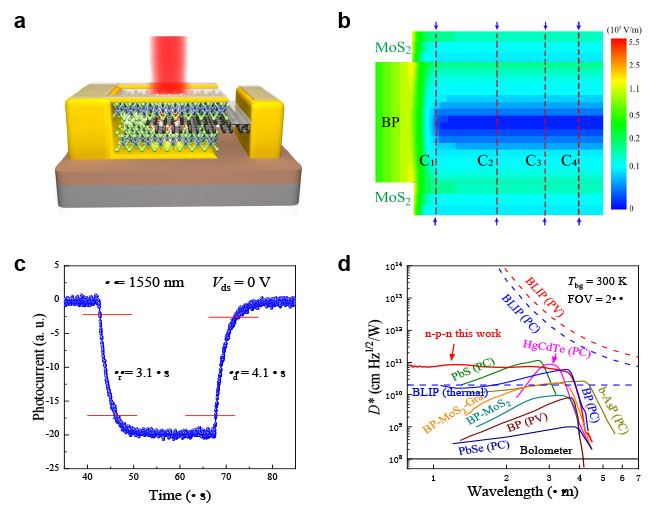|
Van der Waals infrared photodetectors based on 'optical' and 'electrical' combined manipulations
|
|
(Nanowerk Spotlight) Blackbody response is highly desired in
two-dimensional (2D) infrared photodetectors, which determines their
practical applications. State-of-the-art available blackbody response
mid-wavelength infrared (MWIR) photodetectors are fabricated using
materials such as HgCdTe, InSb and InAsSb. However, these photodetectors
need to operate at cryogenic temperatures to minimize thermally
generated dark current and noise, which not only increases the overall
system size and cost but also limits their wide application.
|
|
Due to the quantum confinement effect and the strong light-matter
interaction, 2D materials exhibit many novel features in the
optoelectronic detection field. In particular, 2D materials without
dangling bonds can reduce the noise generated by
generation-recombination and avoid problems such as lattice mismatch.
|
|
However, limited by the thickness and complex defects of 2D materials,
2D photodetectors still suffer from problems such as low quantum
efficiency and large dark current. With the expansion of detection
wavelengths, the above problems of 2D infrared photodetectors will
become more serious.
|
|
In new work (Advanced Materials, "Fully Depleted Self-Aligned Heterosandwiched Van Der Waals Photodetectors"), Fang Wang et al. have demonstrated fully depleted self-aligned van der Waals (vdW) photodetectors based on the MoS2-BP-MoS2
heterosandwiched structure. The structure solved the problems of low
quantum efficiency and large dark current of 2D photodetectors in the
MWIR by combined light field and electric field manipulation.
|
|
In terms of 'optical' manipulation, the top and bottom electrodes in the
sandwiched structure form a microcavity, which can enhance the
resonance of incident light, thereby improving the quantum efficiency of
the photodetector. The optical absorption simulation results
demonstrate that the constructed microcavity structure effectively
realizes the enhanced photoresponse of the photodetector in the
near-infrared band.
|
|
In terms of 'electrical' manipulation, the sandwich structure can
completely deplete the carriers in the infrared absorption layer BP,
thereby achieving effective suppression of dark current and efficient
separation of photogenerated carriers. Additionally, the vertical stack
structure and sandwich fully wrapped electrodes greatly shorten the
transport distance of photogenerated carriers after separation,
effectively reducing the recombination loss of photogenerated carriers
in low-dimensional photodetection and improving the collection
efficiency of photogenerated carriers.
|
|
In addition, a self-alignment process is also introduced into the
structure, which almost eliminates the horizontal transport mode of
photogenerated carriers in the 2D photodetector. At the same time, the
longitudinal transmission distance in the built-in electric field is
completely depleted by tens of nanometers, making the photodetector
achieves a fast response speed.
|
 |
| Figure 1. a, Device structure of the MoS2-BP-MoS2
self-aligned heterosandwiched vdW photodetector. b, Simulated vertical
potential distribution of the photodetector under zero bias. c, Rise and
fall times of the photodetector at zero bias under a 1550 nm laser. d,
Spectral detectivity comparison between the MoS2-BP-MoS2
vdW heterostructure photodetector, other MWIR photodetectors based on
2D materials, and commercially available infrared photodetectors. (Image
courtesy of the researchers)
|
|
Based on the combined 'optical' & 'electrical' manipulation
strategies, the photodetector finally achieved ultra-low noise of 10-25 A2 Hz-1, a blackbody peak responsivity of 0.77 A W−1, and a blackbody peak specific detectivity of 8.61 × 1010 cm Hz1/ 2 W−1 at room temperature.
|
|
This photodetector achieves the widest blackbody response spectrum of 2D infrared photodetectors reported so far.
|
|
Furthermore, the previously reported 2D photodetectors can only exhibit
fast response in the visible or infrared band. Based on the unique
electrical advantages of the fully depleted self-aligned structure, the
photodetector achieve a fast response speed of 4 µs in both the visible
and infrared bands.
|
|
These research results greatly expand the application prospects of 2D
infrared photodetectors in the highly sensitive detection of weak
signals at room temperature.
|
|
Provided by State Key Laboratory of Infrared Physics, Shanghai
Institute of Technical Physics, Chinese Academy of Sciences</pre> |


No comments:
Post a Comment